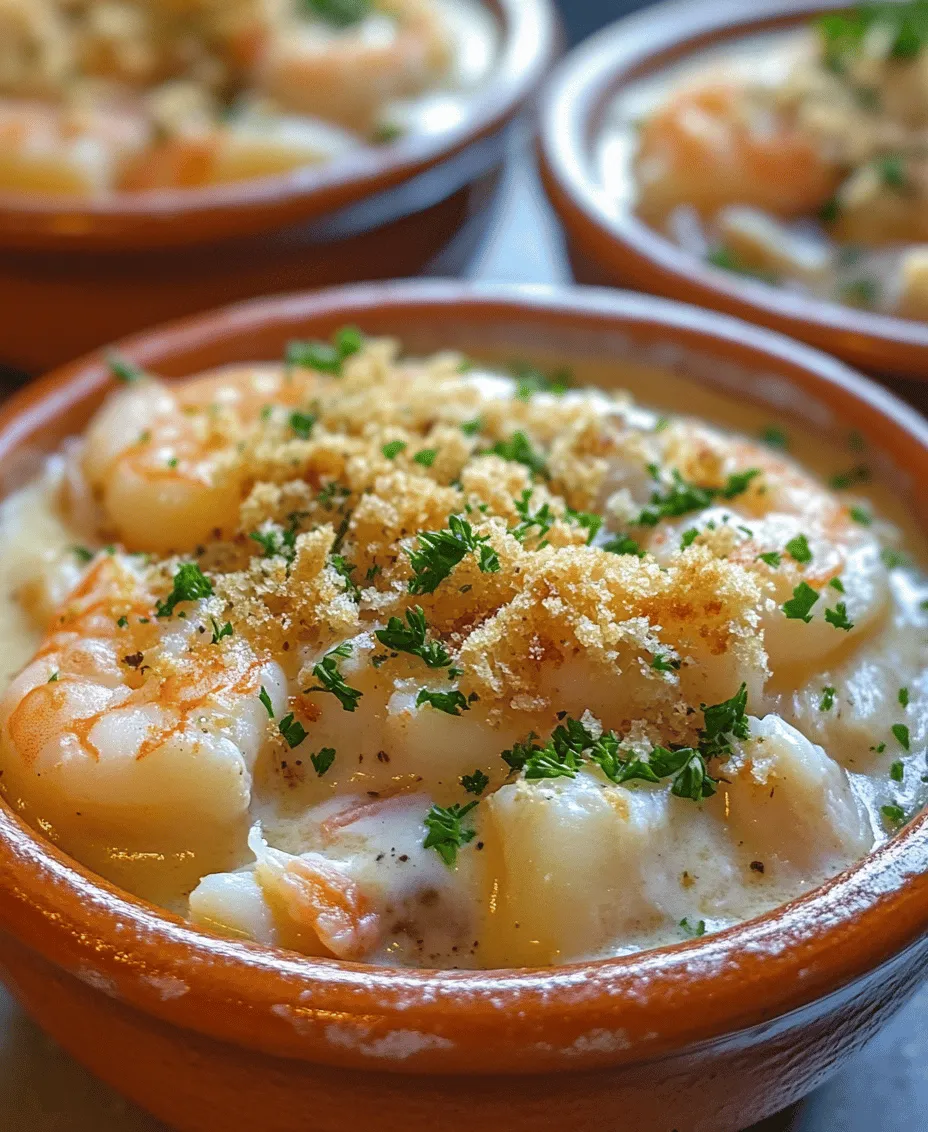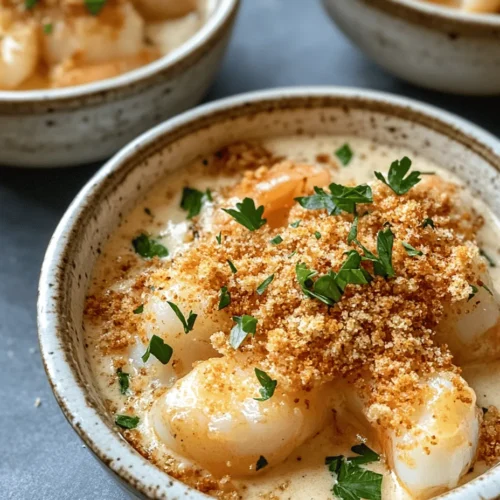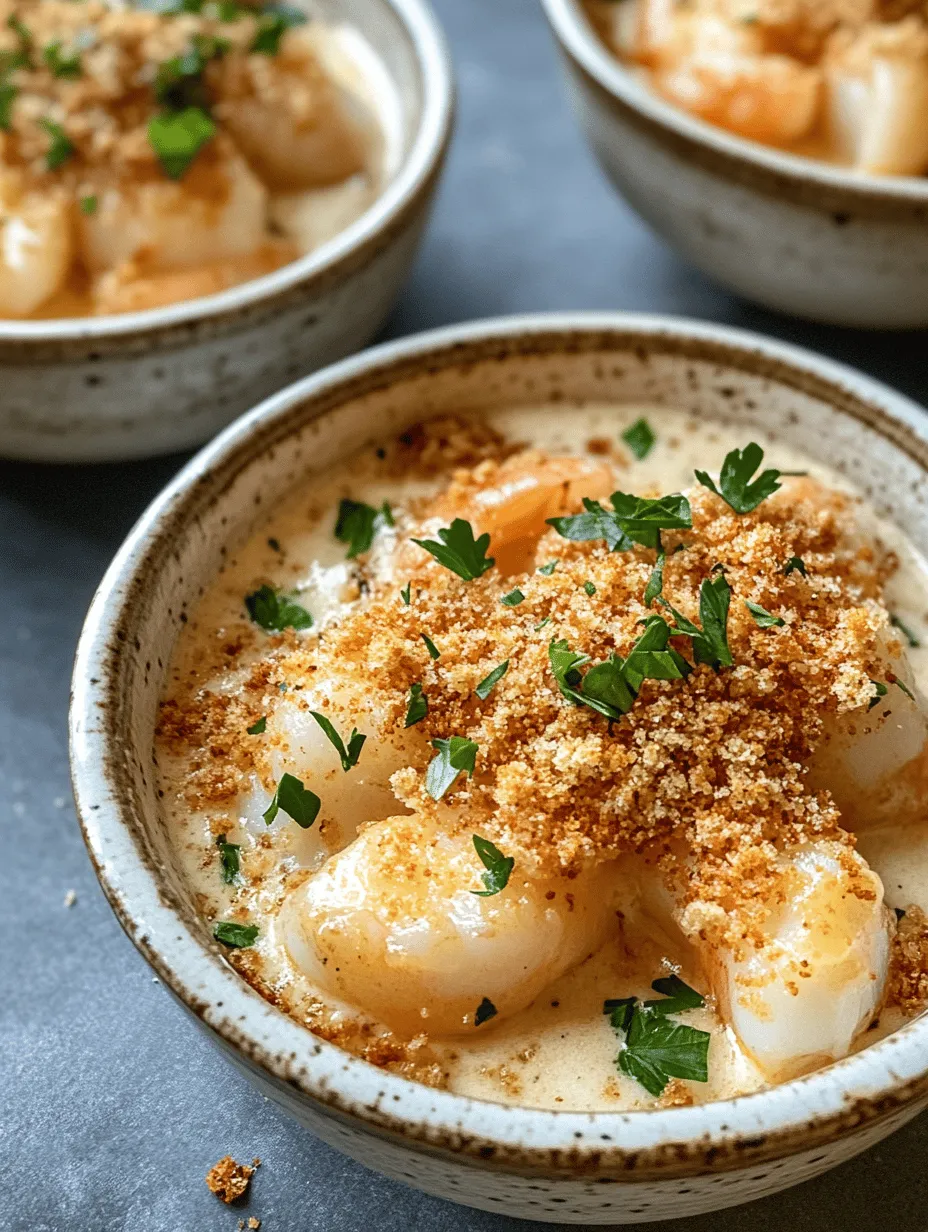In the world of culinary arts, seafood often holds a special place, enticing food lovers with its delicate flavors and rich textures. Among the array of seafood recipes, one standout dish that embodies the essence of gourmet indulgence is the Seafood Cassolette. This exquisite recipe combines succulent shrimp, tender scallops, flaky white fish, and briny mussels, all enveloped in a creamy sauce and topped with a golden crust of Gruyère cheese and breadcrumbs. The result is a delightful medley of flavors and textures that captivates the palate and creates an unforgettable dining experience.
Gourmet Seafood Cassolette is not just a dish; it is an experience, often reserved for special occasions, yet easily approachable for an indulgent weeknight dinner. This recipe represents the perfect marriage of the ocean’s bounty and culinary finesse, making it ideal for impressing family and friends alike. In this article, we will guide you through every step of creating your own gourmet seafood cassolette, ensuring that you can recreate this gourmet delight in your own kitchen.
Understanding the Key Ingredients
To craft the perfect Seafood Cassolette, it’s crucial to understand the key ingredients that make this dish so special. Each component plays a vital role in building flavor and texture, creating a harmonious dish that leaves a lasting impression.
Exploring the Seafood Selection
The Importance of Freshness in Seafood
When it comes to seafood, freshness is paramount. Fresh seafood not only provides better flavor but also ensures food safety. Visit your local fish market or grocery store with a reputable seafood section to select the freshest catches. Look for seafood that smells clean and briny, avoiding any that has an overly fishy odor.
Shrimp: Sweetness and Texture
Shrimp is a star ingredient in this recipe, contributing a natural sweetness and a satisfying texture. Opt for large, raw shrimp for the best results. They should be firm to the touch and translucent in appearance. For a gourmet touch, consider using wild-caught shrimp, which are often more flavorful than their farmed counterparts.
Scallops: A Luxurious Addition
Scallops add a touch of luxury to the cassolette. Their sweet, buttery flavor and tender texture elevate the dish significantly. Look for “dry” scallops, which are free of preservatives and have a superior taste. When purchasing scallops, ensure they are plump and have a slightly milky appearance.
White Fish Varieties: Cod vs. Halibut
Selecting the right white fish can enhance your cassolette’s overall flavor profile. Cod and halibut are both excellent choices due to their flaky texture and mild flavor. Cod is slightly firmer, while halibut offers a buttery richness. Choose whichever you prefer, but make sure it’s fresh and sustainably sourced.
Mussels: The Briny Burst of Flavor
Mussels bring a briny burst of flavor that perfectly complements the other seafood. They should be purchased live, so look for tightly closed shells, which indicate freshness. Discard any mussels with broken shells or those that do not close when tapped. They not only add flavor but also provide an appealing presentation to the dish.
Creamy and Flavorful Bases
A delicious cassolette requires a rich and creamy base that binds all the ingredients together.
Heavy Cream: The Rich Foundation
Heavy cream is the cornerstone of the cassolette’s sauce, providing a luxurious and velvety texture. Opt for heavy cream or double cream for the richest flavor. This ingredient ensures the sauce is thick enough to coat the seafood without being overly runny.
Fish Stock: Elevating the Dish
Using fish stock instead of water adds depth and complexity to the dish. You can make your own by simmering fish bones and scraps with aromatics, or you can purchase high-quality fish stock from the store. The stock enhances the seafood flavor and adds an umami quality that elevates the overall taste.
Aromatics: Onion and Garlic for Depth of Flavor
Onions and garlic are essential aromatics that build the foundation of flavor in the sauce. Sautéing them until they are soft and fragrant releases their natural sweetness, which complements the seafood beautifully. Use yellow onions for a balanced taste, and don’t be shy with the garlic, as it adds a wonderful depth of flavor.
Herbs and Seasonings
To enhance the dish, a thoughtful selection of herbs and seasonings is necessary.
Fresh Thyme: Earthy Notes
Thyme is a classic herb that pairs beautifully with seafood. Its earthy notes complement the delicate flavors without overpowering them. Fresh thyme is preferred for its vibrant flavor, but dried thyme can be used in a pinch.
Dill: Brightness and Aroma
Dill adds a bright, aromatic quality that enhances the overall flavor profile of the cassolette. Its unique taste works harmoniously with seafood, making it a perfect addition to the sauce. Fresh dill is ideal for its robust flavor, but dried dill can also be used if fresh is unavailable.
Balancing with Salt and Pepper
Don’t forget to season your dish well with salt and pepper. These fundamental seasonings help to elevate the flavors of the seafood and enhance the richness of the sauce. Always taste as you go to ensure a balanced flavor.
Cheesy and Crunchy Topping
The topping of the cassolette is what elevates it from a simple seafood dish to a gourmet experience.
Gruyère Cheese: Creamy and Nutty
Gruyère cheese is a fantastic choice for the topping due to its creamy texture and nutty flavor. It melts beautifully, creating a delightful crust that contrasts with the creamy seafood filling. For a richer flavor, consider blending it with a bit of Parmesan cheese.
Breadcrumbs: For a Textural Contrast
Breadcrumbs add a necessary textural contrast to the cassolette. When mixed with melted butter and herbs, they create a crunchy topping that complements the creamy base. Use panko breadcrumbs for extra crunch, or make your own from stale bread for a more rustic touch.
Step-by-Step Instructions for Preparation
Now that you have a good understanding of the ingredients involved, it’s time to dive into the preparation of your Gourmet Seafood Cassolette. This section will guide you through the initial steps needed to ensure your dish turns out perfectly.
Preparing the Ingredients
Importance of Proper Seafood Cleaning and Preparation
Before cooking, it’s essential to clean and prepare your seafood properly. Rinse the shrimp under cold water, devein them if necessary, and pat them dry. For scallops, remove the side muscle if present and rinse gently. Scrub the mussels under cold water to remove any sand or debris, discarding any that do not close when tapped. Fresh, well-prepared seafood is crucial for achieving the best flavor and texture in your cassolette.
Chopping Vegetables: Techniques for Uniformity
Uniformity in vegetable chopping ensures that they cook evenly. Dice the onion finely and mince the garlic to maximize their flavor release. For fresh herbs like thyme and dill, chop them coarsely to release their aromatic oils while maintaining some texture. This attention to detail will enhance the overall presentation and flavor of your dish.
The Cooking Process
Preheating the Oven: Setting the Stage
The first step in the cooking process is to preheat your oven to 375°F (190°C). This ensures that your cassolette will bake evenly and that the cheese topping will melt and brown beautifully. While the oven is heating, you can prepare the creamy sauce that will envelop the seafood.
The next phase involves sautéing the aromatics and building the sauce. This will create a rich base that will absorb the flavors of the seafood as it bakes. Once the oven is ready, and your sauce is prepared, you will be on your way to creating a luxurious Gourmet Seafood Cassolette that is sure to impress everyone at the table.
Stay tuned for the continuation of this culinary journey, where we will delve into the detailed cooking process and finalize this gourmet masterpiece!

Sautéing Aromatics: Building Flavor Layers
To begin crafting your gourmet seafood cassolette, the first step is sautéing the aromatics. This is a crucial phase where you develop the foundational flavors that will elevate your dish. Start by heating a generous tablespoon of olive oil and a tablespoon of butter in a large skillet over medium heat. Once the butter has melted and the mixture is shimmering, add finely chopped onions and minced garlic.
Sauté these aromatics for about 3-4 minutes, or until the onions become translucent and fragrant. You can also add finely chopped celery and bell peppers at this stage for an added depth of flavor. These ingredients should be cooked just until they soften, which typically takes another 2-3 minutes. Stir continuously to prevent them from browning too much; you want a gentle sauté that allows the flavors to meld beautifully without burning.
As the aromatics cook, consider adding a pinch of salt and freshly cracked black pepper. This seasoning will draw out moisture and enhance the overall flavor profile of your dish. Once your aromatics are perfectly sautéed, it’s time to move onto the seafood.
Cooking the Seafood: Achieving the Perfect Texture
The seafood is the star of your cassolette, so it’s essential to treat it with care. Choose a mix of your favorite seafood, such as shrimp, scallops, and mussels. Start by preparing your seafood: if you’re using shrimp, peel and devein them; if you’re using scallops, pat them dry with a paper towel to ensure a sear rather than steam.
After your aromatics are ready, increase the heat slightly and add the seafood to the skillet. Cook the seafood for about 2-3 minutes, or until just cooked through. The shrimp should turn pink, the scallops should develop a light golden crust, and the mussels should begin to open. Remember, the seafood will continue to cook in the oven, so you want to undercook it slightly to maintain its tender texture. Once the seafood is cooked, remove it from the skillet and set it aside while you prepare the sauce.
Creating the Sauce: Balancing Cream and Stock
In the same skillet, it’s time to create a luscious sauce that will bind your cassolette together. Begin by adding a splash of white wine to deglaze the pan, scraping up any bits stuck to the bottom for added flavor. Let the wine simmer for 1-2 minutes until it reduces slightly.
Next, pour in about a cup of seafood stock or homemade fish stock for a deeper flavor. Allow this to simmer for another 5 minutes to combine the flavors. Afterward, reduce the heat to low and slowly stir in a cup of heavy cream. This creamy base will provide richness and smoothness to your dish. To enhance the flavor further, add a teaspoon of Dijon mustard, some chopped fresh herbs like parsley or dill, and season with salt and pepper to taste. This sauce is the heart of your cassolette, so ensure it’s well-balanced and flavorful.
Assembling the Cassolette: Layering for Optimal Flavor
Now that your seafood and sauce are ready, it’s time to assemble the cassolette. Preheat your oven to 375°F (190°C). In a large baking dish or individual cassolette dishes, begin by spooning a layer of the creamy sauce into the bottom. Then, add your sautéed seafood, distributing it evenly across the dish.
For additional texture and flavor, consider adding a layer of blanched vegetables, such as asparagus or green beans. Top with more of the creamy sauce, ensuring everything is well-coated. Finally, sprinkle a generous amount of grated cheese on top; Gruyère or Parmesan work wonderfully for a golden, bubbly finish.
Baking to Perfection
The Importance of Baking Time and Temperature
Baking your cassolette is where the magic happens. Place the assembled dish in the preheated oven and bake for about 25-30 minutes. This baking time will allow the cheese to melt beautifully, creating a golden crust on top while the flavors meld together.
Visual Cues for Doneness: Recognizing the Golden Top
Keep a close eye on your cassolette during the last few minutes of baking. You’re looking for a golden, bubbly top as a sign of doneness. If you like an extra crispy topping, you can place the dish under the broiler for an additional 2-3 minutes, but watch it closely to prevent burning. Once perfectly baked, remove your cassolette from the oven and let it rest for about 5 minutes before serving.
Serving Suggestions and Pairings
Presenting Your Seafood Cassolette
When it comes to serving your seafood cassolette, presentation plays a key role in the dining experience. Choose elegant, individual cassolette dishes for a more refined presentation, or opt for a large baking dish for family-style sharing.
Choosing the Right Serving Dishes
Consider using white or light-colored dishes to showcase the vibrant colors of the seafood and creamy sauce. This contrast will make your dish visually appealing and enticing.
Garnishing Techniques for Visual Appeal
For an added touch, garnish with fresh herbs such as parsley, chives, or dill right before serving. A sprinkle of lemon zest can also brighten the flavors and add a pop of color.
Ideal Side Dishes
Complementary Salads for Freshness
To balance the richness of the cassolette, consider pairing it with a fresh salad. A simple arugula salad dressed with lemon vinaigrette or a classic mixed green salad with cherry tomatoes, cucumber, and a light balsamic dressing would make excellent accompaniments.
Bread Options: Crusty Baguette or Garlic Bread
Don’t forget the bread! A crusty baguette is perfect for sopping up the creamy sauce, while garlic bread can add a delightful flavor contrast. Serve the bread warm, perhaps with a side of herbed butter for an extra indulgence.
Beverage Pairings
Wine Suggestions: White vs. Sparkling
For beverage pairings, consider a crisp white wine such as Sauvignon Blanc or a light Chardonnay to complement the seafood’s flavors. If you prefer something bubbly, a sparkling wine or Champagne can enhance the celebratory nature of the dish.
Non-Alcoholic Options: Sparkling Water and Herbal Teas
For non-alcoholic options, serve sparkling water with a slice of lemon or a refreshing herbal tea, like mint or chamomile, which can cleanse the palate beautifully.
Nutritional Benefits of Seafood
Health Benefits of Key Ingredients
Seafood is not only a delicious choice but also offers a plethora of health benefits. Rich in omega-3 fatty acids, seafood is known for its heart-healthy attributes, supporting cardiovascular health and reducing inflammation.
Protein Content: Fueling and Satiating
Additionally, seafood is packed with high-quality protein, making it an excellent choice for those looking to maintain or build muscle. It’s a filling option that helps keep you satiated, making it ideal for a wholesome meal.
Vitamins and Minerals from Seafood and Herbs
Moreover, seafood is rich in essential vitamins and minerals, such as vitamin D, zinc, and B vitamins, all of which contribute to overall health. Fresh herbs used in the cassolette also provide antioxidants and additional nutrients.
Balancing Indulgence with Nutrition
Enjoying Seafood in a Balanced Diet
While the gourmet seafood cassolette is certainly a treat, it’s important to enjoy it as part of a balanced diet. Incorporating various food groups, such as vegetables and whole grains, can enhance its nutritional profile.
Understanding Portion Sizes
Be mindful of portion sizes to ensure you’re fueling your body appropriately without overindulgence. A serving size that includes a scoop of cassolette, a side salad, and some bread is a great way to enjoy the dish while maintaining balance.
Conclusion: Relishing the Experience of Gourmet Seafood Cassolette
The gourmet seafood cassolette is not just a meal; it’s an experience that tantalizes the taste buds and brings a touch of elegance to your dining table. By following the steps outlined in this article, you can create a dish that showcases the finest seafood flavors, wrapped in a creamy, cheesy embrace. Whether you’re hosting a dinner party or simply treating yourself to a special meal, this cassolette promises to deliver warmth, comfort, and culinary delight. Embrace the process, savor the flavors, and enjoy the art of gourmet cooking with this delightful recipe.


